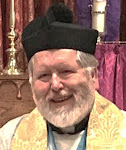In our journey to the baptismal celebration at Easter, the Church provides us this day with some powerful Mass readings. First is the story of Naaman - an “outsider” with leprosy - who was to humble himself and be washed in the Jordan in order to know the healing power of the Lord (2 Kings 5:1-15). Then there is the Gospel reading (Luke 4:24-30 ) in which Jesus - who came to bring savation to everyone - refers to the story of Naaman in order to show that “outsiders” are sometimes far more responsive to God than those who have grown up in the community of faith.
As we continue to make our way through Lent, let’s examine OUR hearts to ensure that pride doesn’t prevent us admitting our spiritual illnesses, or being responsive to the Lord, who has so much love, power and healing to bestow upon us.
Actually, it is good for us to think about the haunting significance of the Jordan River. In the words of Fr Thomas Hopko (in The Winter Pascha):
The river Jordan plays a very important role in the Bible. Before it becomes the river in which Jesus the Messiah baptized, it is revealed as the river which bounds the “Promised Land.” To cross the Jordan, for the people of Israel, was to enter into the fulfillment of the Lord’s promises. It was to enter the “land flowing with milk and honey,” the place where God would dwell with His people providing them with the endless blessings of His presence.
In the New Testament, with it spiritual and mystical fulfillment of the Old, to cross the Jordan was to enter into the Kingdom of God, to experience the fullness of the life of the age to come. The fact that Moses was not blessed to cross the Jordan thus became a symbol of the fact that the Law by itself could not save Israel or the world. It had to be Joshua, which literally means Savior, and is the Hebrew form of the Greek word Jesus, who leads the people across the Jordan and into the promised land, thus symbolizing the saving action of the new Joshua, Jesus the messianic Savior, in the covenant of grace (see Joshua 1:12).
When Joshua came to the Jordan the streams parted at the presence of God’s people, with the priests bearing in their hands the Ark of the Covenant. As the waters of the sea parted to allow God’s people to pass through as if on dry land at their exodus from Egypt, so also at the entry into the land of promise, the river of Jordan made way for God’s people to pass through into the place of their final destination (Joshua 3:11-13).
The Lord also commanded Joshua to take twelve stones out of the river Jordan and to place them together in one place in a pile where the people had passed through, to remain “to the people of Israel as a memorial forever” of what the Lord had done for them (Joshua 4:8-10).
After the people passed through the Jordan River, “the waters of the Jordan returned to their place and overflowed all its banks, as before.” (Joshua 4:18) This miraculous wonder became part of the living memory of Israel, and the event was celebrated in the worship of God’s people ever since. The psalms which recall the divine action are sung at the Church’s festival of the Epiphany as prefigurations of God’s final act of the salvation of all people in the death and resurrection of His Anointed, the Beloved Son who was baptized in the same Jordan streams.
“What ails you, O Sea that you flee O Jordan, that you turn back?... Tremble, O earth, at the presence of the Lord, at the presence of the God of Jacob” (Psalm 114:5,7)
The river Jordan was also parted by the passage of Elijah and Elisha, an event also recalled at the liturgy of Epiphany. (2 Kings 2) And it was from the Jordan that Elijah was taken up into heaven in order to return again, as the tradition developed, to prepare the way for the coming of the Messiah. (See Mt 17:9-13) It was also in the Jordan that Naaman the Syrian was cleansed from his leprosy, a sign referred to by Jesus as a prefiguration of the salvation of all people, not only those of Israel. (Lk. 4:27) In the account of Naaman’s cure the special significance of the Jordan is stressed once again.
“He [Naaman] went down and dipped himself seven times in the Jordan, according to the word of the man of God; and his flesh was restored like the flesh of a little child, and he was clean.” (2 Kings 5:13,14)
Can we not be washed in just any river and be clean? God answers, No. Only in the Jordan, in the baptism of Christ, are we cleansed from all of our sins. Only through the Jordan do we enter into the land of the living, the Promised Land of God’s kingdom. Only by the sanctified waters of the Jordan does God sanctify us forever.
The River Jordan turned back of old,
Before Elisha’s mantle when Elijah ascended.
The waters were made to part in two,
So the wet surface became a dry path.
This was in truth a symbol of baptism
By which we pass through mortal life.
Christ has come to the Jordan to sanctify the waters.
- Troparion of the prefeast of Epiphany.

























